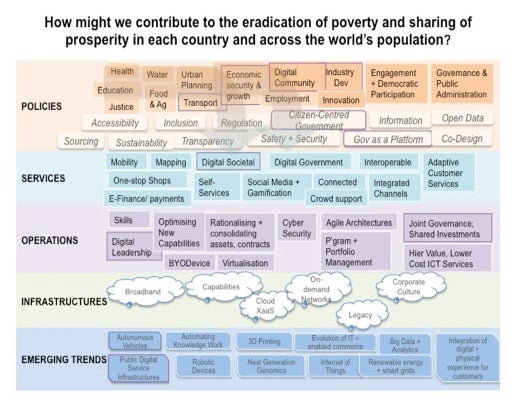
“ There is almost nothing that government can or should do alone,” said one of the panelists at a recent global webinar on the future of digital government. [1]
This was just one of the many signals of the disruptive and creative impact that digital platforms, dynamic connections and cross-sector co-design and participation are having on the role and practice of governments. While some are resisting, the outcomes that many predicted in the early days of e-government are now possible through “silo-busting,” merged back-office infrastructures and focused collaborative relationships with civil society, businesses, citizens and communities. To some degree, this reflects Professor Carlotta Perez’s creative construction phase of a revolution (also described in this paper) and reinforces two critical success factors: execution and deployment capabilities.
Eight senior government leaders from the World Bank-sponsored High–Level Experts, Leaders and Practitioners (HELP) network, together with participants from 35 countries, led a discussion on the challenges and opportunities associated with digital government.
Intriguingly, there are few differences between developing and developed nations in obtaining policy outcomes using information and communications technology (ICT) and e-government other than those related to specific vision, priorities and capability. While cloud services and mobile technologies are driving substantial delivery benefits, there are many challenges impacting substantive digital ‘deployment’ and institutional change, including:
- Resources, people and skills;
- Methods, processes and re-engineering;
- Mindset and leadership;
- Accountabilities;
- Expectations of decision-makers for certainty vs flexibility;
- Complexity management;
- Citizen demand;
- Eco-system engagement and co-design;
- Collaboration and innovation; and
- Knowledge sharing.
Now, having (almost) overcome many of the structural and accountability barriers of ”siloed” government, or at least knowing what needs to be established and working out how best to do this [2], the leading countries are moving to share their common e-infrastructure platforms with stakeholders well beyond traditional government boundaries. This is being determined at cabinet and Head of Government levels in many instances.
Digital government is now a central policy matter, paramount to delivering consolidated capabilities, shared policy and business intelligence, and administrative efficiencies. Cohesive governance, standards and integrated architectures – as well as policies such as Digital by Default, Open Data by Default, citizen-driven design, open markets, cloud services and associated platforms – are finally demonstrating the benefits of ”silo-busting”!
New value is possible in partnership with civil society and the private sector. New solutions to old problems can be designed and delivered outside of government using e-infrastructure and collaborative processes with new apps and new businesses. The concept of government as a platform (see Tapscott and O’Reilly) is being realized.
So the future of government means:
- Digital underpins how government works and relates, it is not just automation or more devices
- Government will be disrupted and develop through open partnerships with civil society and the private sector and this collectively is expected to generate jobs, economic and social growth and even happiness – in some countries and regions this is described as Government 3.0[3];
- Determining a judicious balance between top-down and outside-in defined priorities for government services and policy settings;
- Having shared digital e-infrastructures for government, business and civil society;
- Co-design and delivery of apps and services with citizens and small enterprises to identify problems; reduce risk (of failure) by involving users; test prototypes that increase awareness of what works or doesn’t work; and expanding the range of suppliers/providers beyond government; and
- Services and initiatives underpinned by Digital by Default and Open Data policies.


Join the Conversation